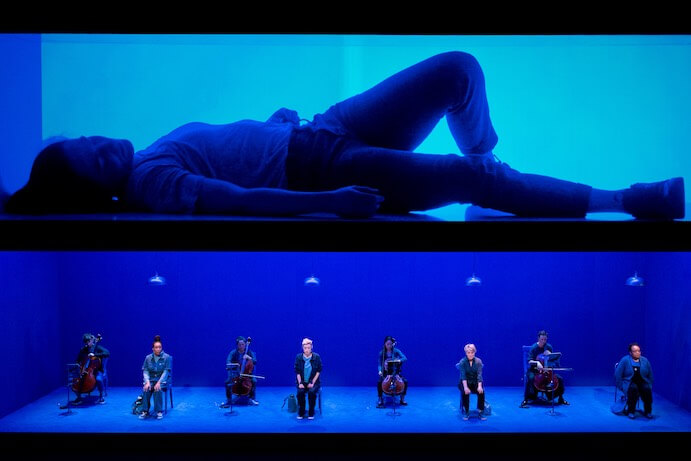Content warning: sexual assault
How should opera deal with sensitive subject matter? Recently, the Royal Opera House (ROH) director of opera Oliver Mears addressed problematic aspects of the operatic canon, works where ‘male composers fetishised the suffering of women, whose powerlessness is signalled by their inevitable deaths by murder, suicide or agonising illness.’ But he did not move one step further and consider that different perspectives – specifically, perspectives from female creative artists – might produce different responses to difficult topics and diversify the repertoire. He also failed to mention a controversial recent (2015) staging at the ROH of Rossini’s Guillaume Tell, where nudity and a gang rape scene, a gratuitous directorial addition, made headlines beyond the culture pages.
Let’s have some different ideas. The Blue Woman, a new opera by composer Laura Bowler and a female-led creative and performance team, was the central event of the ROH’s Engender Festival, taking place in the venue’s smaller Linbury Theatre. Focusing on advocacy, development, and mentoring of women and non-binary creative artists, the week-long festival, an annual event since 2019, aims to ‘drive transformational change’ in gender representation in opera.
Laura Bowler–Photo by Robin Clewley
For The Blue Woman, Laura Lomas’ poetic libretto deals with the aftermath of a sexual assault – how a woman deals with trauma. The point is not to witness the traumatic event in a voyeuristic manner, but to feel compassion for the woman at the centre of the story. The libretto unfolds loosely over the course of a day, moving from a scene set in a room through a train journey to the city, Bowler creating labyrinthine textures from the text that tend to focus on single words (‘woman’, ‘feel’). A hideous stylised police station scene, with a recorded narrative overlaid by a live singer trying desperately and without success to communicate, is followed by a final sequence where a woman is left alone, reiterating lines of text obsessively as she walks through the night until daybreak. Bowler is not afraid to dwell on a single idea in this final section, sitting in the emotion. The concluding gesture is equivocal, with unstable cello lines interrupted by what sounded like metallic white noise.
Director Katie Mitchell created a striking stage picture with four female vocalists lined up, each paired with a cellist; none of the vocalists move from their position other than to stand up and sit down. The stage performers were sometimes a fractured and destabilised single being: the metaphor is the traumatised individual whose sense of self is shattered. The women, of varying ages and ethnicities, were dressed in everyday clothes and each singer had a handbag. Their gestures were also everyday, looking pensive or tired or rummaging in their bag. They were everywoman – they were us.
Elaine Mitchener in The Blue Woman–Photo by Camilla Greenwell
The Blue Woman’s cast was a roll-call of leading contemporary vocalists and cellists conducted by Jamie Man. Soprano Gweneth-Ann Rand was a still presence on stage whose voice effortlessly captivated. The plangent-toned mezzo Lucy Schaufer’s interventions were always profoundly touching, and the small gestures of Elaine Mitchener spoke volumes while, as ever, she was an absolutely compelling vocal performer.
In the final sequence of the opera, Rosie Middleton had the principal narrative burden; she rose to the occasion with superlative communication and perfectly placed arresting high interjections. The cellists (Louise McMonagle, Su-a Lee, Tamaki Sugimoto, and Clare O’Connell) acted more as a group of four, sometimes underpinning the texture unobtrusively, but more often creating instability of pitch and timbre, reflecting on and extending the emotion of the singers. Bowler gave the remarkable percussionist Angela Wai-Nok Hui, playing in the pit, connecting or punctuating phrases, and her shocking drum rolls, ratchets, and metallic sonorities vividly underlined key moments.
Rosie Middleton in The Blue Woman–Photo by Camilla Greenwell
The sound design created immersive textures, adding to the multi-layered work, and a film projected above the performers added a further dimension. Images of water and sky allowed space for the music, but elsewhere, the film was the least successful element: for me, images of very familiar London train journeys and streets added a concrete dimension that was too linked to a specific location and drew attention away from the live performance.
The Blue Woman provided a creatively mediated voice for trauma, one that drew us empathically into the female characters’ feelings and centred their story. It was a success in its own terms as the centrepiece of the Engender Festival — but the challenge now is for the Royal Opera House to move beyond this focal event by transferring its insights to their programming in the main house.
I CARE IF YOU LISTEN is an editorially-independent program of the American Composers Forum, funded with generous donor and institutional support. Opinions expressed are solely those of the author and may not represent the views of ICIYL or ACF.
A gift to ACF helps support the work of ICIYL. For more on ACF, visit the “At ACF” section or composersforum.org.

